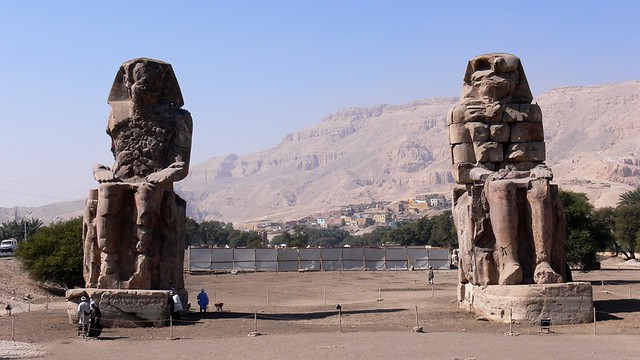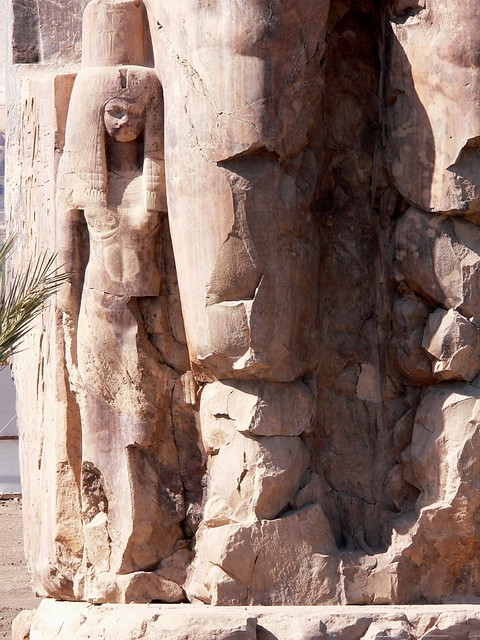Colossi of Memnon
Submitted by walwyn
The Colossi of Memnon are two enormous statues that sit on the west bank of the Nile near Luxor, facing east toward the sunrise. Each one shows Pharaoh Amenhotep III seated on a throne, hands resting on his knees, looking out across the river toward the land of the living. They were built around 1350 BCE to stand at the entrance of his mortuary temple, a complex so large it once covered about 35 hectares, bigger than the Temple of Karnak. Most of that temple is gone now, washed away by floods and reused as building stone, but the two statues remain.
Each figure is about 18 meters (59 feet) high and weighs roughly 720 tons. They’re carved from quartzite sandstone that was brought more than 600 kilometers down the Nile from quarries at Gebel el-Silsila. The thrones are decorated with carvings showing the Nile gods tying together the plants of Upper and Lower Egypt—a symbol of unity—and small images of Amenhotep’s mother Mutemwiya, his queen Tiye, and several of his daughters appear beside his legs. The statues probably stood in front of a large stone gateway that led into the temple proper, so visitors would have walked between them as they entered.

One of these smaller carvings, still visible today, shows Queen Tiye standing beside the king’s right leg. She wears a long close-fitting dress and a vulture headdress topped with a crown and plumes, marks of her royal and divine role. Though she is more than four meters tall, she appears tiny compared to the seated pharaoh, emphasizing his authority and god-like presence while still showing her importance in his reign.
An earthquake in 27 BCE cracked the northern statue across the torso, and afterward it began to make a strange humming sound at sunrise. Ancient visitors believed it was the voice of the hero Memnon calling to his mother, the goddess of the dawn, and the name “Colossi of Memnon” has been used ever since. Roman emperors and travelers came to hear the sound, but after repairs were made, the singing stopped.
Today the statues stand alone on the open plain, with the cliffs of Thebes rising behind them and green fields stretching toward the Nile. Their upper parts are badly damaged, but up close the details are still impressive—the carvings, the scale, and the sheer presence of the figures. Excavations around them continue to uncover pieces of Amenhotep’s vast temple, including other colossal statues and decorative fragments. Even in their ruined state, the Colossi of Memnon remain one of the most powerful reminders of Egypt’s New Kingdom, linking royal image, myth, and monument in the desert light.
